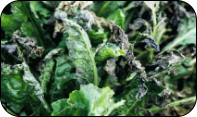What is Cercospora Leafspot?
Cercospora leafspot fungus (Cercospora beticola Sacc.) causes one of the most widespread, destructive and economically significant sugarbeet diseases in the world.The Cercospora leafspot fungus feeds on the sugarbeet's sap. Fifteen to 30 spots per leaf will not appreciably interfere with plant functions. It is the subsequent loss of the whole leaf (or large leaf portions) that interferes with normal development of the beet root and sugar storage. The leafspot fungus infects portions of outer (older) leaf blades first. Decreased photosynthetic capacity (disease, hail, etc.) lowers yield and sugar content; and these are further lowered by energy expended to grow new leaves. The unexpected demand for new foliage prevents normal root growth and sugar storage in the beet. This results in reduced yield, sugar content and juice purity of the root. The degree to which yield, sugar and purity are reduced depends on the severity; prolongation of the leafspot attack; and the time in the season when it occurs. Early prolonged attacks are the most damaging. Early attacks that occur during the last half of July and August affect growth in terms of both tons per acre and sugar content; late August and September attacks have more affect on sugar storage than on yield. A severe attack will reduce yield and sugar content significantly. The degree to which yield, sugar and purity are reduced depends on the severity; prolongation of the leafspot attack; and the time in the season when it occurs. Early prolonged attacks are the most damaging. Early attacks that occur during the last half of July and August affect growth in terms of both tons per acre and sugar content; late August and September attacks have more affect on sugar storage than on yield. A severe attack will reduce yield and sugar content significantly.
Symptoms:
The first visible effect of Cercospora is extremely small, whitish spots on the leaf blades. These spots rapidly increase in size, becoming brownish or bright purple in colour. Spots are scattered over the surface, occurring less frequently on the stems. The first individual spots are nearly circular in outline, but become united with other spots in increasing numbers. Mature spots are 1/8 inch in diameter with border colours ranging from brown to purple. The interior of the spot looks ashen gray due to the many spores. When spots become numerous, leaves gradually turn yellow; and finally turn brown and die. Dead leaves shrivel, but remain firmly attached to the crown making defoliation more difficult at harvest.
Cause:
Increased incidences of Cercospora leafspot are favoured by high temperatures and periods of free moisture or leaf wetness on the foliage (i.e., rain showers, heavy dews or lingering fog). Optimum conditions for Cercospora development are day temperatures of 25 to 35C (77 to 95 F) with night temperatures above 15.6C (60 F), coupled with 90 to 95% relative humidity causing leaf wetness periods. Very little infection occurs below 15C (59 F). The remnants of diseased beet leaves left in fields are the most common source of infection. Infection may also come from other host plants such as common lamb's quarters, redroot pigweed, curly dock, prickly lettuce and dandelion. Splashing rain and to some extent wind, are additional means of spreading the disease.
|
 The degree to which yield, sugar and purity are reduced depends on the severity; prolongation of the leafspot attack; and the time in the season when it occurs. Early prolonged attacks are the most damaging. Early attacks that occur during the last half of July and August affect growth in terms of both tons per acre and sugar content; late August and September attacks have more affect on sugar storage than on yield. A severe attack will reduce yield and sugar content significantly.
The degree to which yield, sugar and purity are reduced depends on the severity; prolongation of the leafspot attack; and the time in the season when it occurs. Early prolonged attacks are the most damaging. Early attacks that occur during the last half of July and August affect growth in terms of both tons per acre and sugar content; late August and September attacks have more affect on sugar storage than on yield. A severe attack will reduce yield and sugar content significantly.
